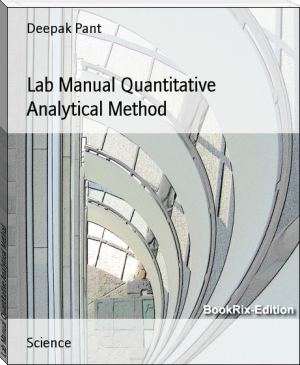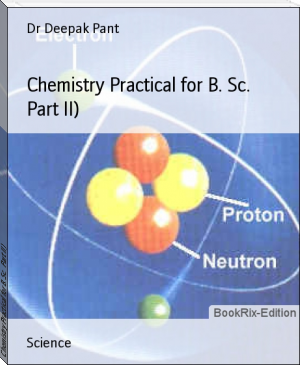Inorganic Chemistry Practical by Dr Deepak Pant (the reading strategies book txt) 📖

- Author: Dr Deepak Pant
Book online «Inorganic Chemistry Practical by Dr Deepak Pant (the reading strategies book txt) 📖». Author Dr Deepak Pant
Inorganic Chemistry Practical
Under UGC Syllabus for M.Sc. (Previous) in all India Universities
1. Qualitative and Quantitative Analysis
(a) Qualitative analysis of mixtures containing not more than six radicals including:
(i) Rare-earth elements
(ii) Anions, which have not been done in under graduate practical.
(iii) Insoluble. (4-30)
(b) Quantitative Analysis of mixtures of metal ions involving Volumetric (by complexometric titration using masking and demasking agents) and gravimetric analysis. (38-42)
2. Chromatography
Separation of cations and anions by- Paper Chromatography/ Thin Layer Chromatography (48-60)
3. Preparations (60-76)
Preparation of selected inorganic compounds:
VO (acac)2
TiO(C9H8NO)2.2H2O
cis-K[Cr(C2O4)2(H2O)2]
Na[Cr(NH3)2(SCN)4]
Mn(acac)3
K3[Fe(C2O4)3]
Prussian Blue, Tumbull’s Blue.
Co[(NH3)6][Co(NO2)6]
cis-[Co(trien)(NO2)2]Cl.H2O
Hg[Co(SCN)4]
[Co(Py)2Cl2]
[Ni(NH3)6]Cl2
Ni(dmg)2
[Cu(NH3)4]SO4.H2O
1. Qualitative Analysis
Experiment 1. To identify acidic and basic radical in the given mixture.
Experiment 2. To identify the interfering radicals in the given mixture.
Experiment 3. To identify Borate, Chromate, permanganate in the given inorganic mixture.
Experiment 4. Identify Sulphate in the presence of Sulphite and sulphide.
Experiment 5. Identify interfering radicals in the given inorganic mixture.
Experiment 6. Identify halogens in the given mixture in the presence of each other.
SALT ANALYSIS
• Introduction
• Confirmation tests for Acidic Radicals
• Confirmation tests for Basic Radicals
• Data files used
• Main Program
• Output Verification List
INTRODUCTION TO SALT ANALYSIS
Usually a salt contains at least one Basic Radical and one acidic radical. We must identify the name of the basic radical and acidic radical to name the salt and to use without confusion. We can say that identification of various elements such as acidic radicals and basic radicals that are present in a salt is called as Salt Analysis. In schools and in colleges students use different books and tables to help them in salt analyzing. Most of the students cannot understand them and take decision that is what should be done in next step. This program can help them by giving instructions about next step.
By using this program, we can identify 22 basic radicals and 14 acidic radicals. The basic radicals are as follows,
1. Aluminium 2. Ammonium 3. Antimony
4. Arsenic 5. Barium 6. Bismuth
7. Cadmium 8. Calcium 9 . Chromium
10 . Cobalt 11. Copper 12. Ferric
13. Ferrus 14. Lead 15.Magnesium
16. Manganese 17. Mercury 18.Nickel
19. Strontium 20. Tin 21.Zinc
22. Silver
The acidic radicals are as follows,
1.Arsanide 2.Arsenate 3.Borate
4.Bromide 5.Carbonate 6.Chloride
7.Chromate 8.Flouride 9.Iodide
10.Nitrate 11.Oxalate 12.Phosphate
13.Sulphide 14.sulphate
CONFIRMATION TESTS FOR ACIDIC RADICALS
1.Arsanide 2.Arsenate 3.Borate
4.Bromide 5.Carbonate 6.Chloride
7.Chromate 8.Flouride 9.Iodide
10.Nitrate 11.Oxalate 12.Phosphate
13.Sulphide 14.sulphate
ARSENATE
To 2 ml of extract add dil.HNO3 till there is no effervescence. Add Silver Nitrate Solution. If precipitate is formed filter it. Add ammonium Hydroxide along the walls of test tube.
RESULT: Chocolate brown ring at the neutral zone.
ARSENIDE
To 2 ml of the extract add dil. HNO3 till there is no effervescence. Pass H2S.
RESULT: Yellow precipitate appears.
BORATE
1. Boron Tri Fluoride Test:
Mix a little of the substance with Borax and Conc.H2SO4 in a test tube. Heat and set fire to the vapor.
RESULT: Green flame appears.
2.Ethyl Borate Test:
To a little of the substance in a test tube add about 1 ml of Conc. H2SO4 and 2 ml of Ethyl Alcohol . Heat and set fire to the vapour.
RESULT: Green edged flame.
BROMIDE
Mix the substance with a little MnO2.Add Conc.H2SO4 and warm.
RESULT: Reddish brown gas turning starch iodide paper Blue.
CARBONATE
Add a few ml of diluted HCl to a little substance in a test tube.
RESULT: Brisk effervescence. Colorless, odourless gas turning lime water milky.
CHLORIDE
Chromyl Chloride test:
Heat 0.1 gm of the substance with 0.3 gm of Potassium Chromate and 1 ml of Conc.H2SO4.Pass the red vapour of Chromyl Chloride into a little water. Add NH4OH and acetic acid add lead acetate.
RESULT: Yellow precipitate appears.
CHROMATE
Heat 0.1 gm of the substance with Sodium Chloride 0.3 gm of Potassium dichromate and 1 ml of Conc.H2SO4.Pass the red vapours of Chromyl chloride into water. Add NH4OH and acetic acid and lead acetate.
RESULT: Yellow precipitate appears.
FLOURIDE
Boron Tri Fluoride test:
Mix a little of the substance with Borax and Conc.H2SO4 in a test tube. Heat and set fire to the vapour.
RESULT: Green flame appears.
IODIDE
Mix the substance with a littleMnO2.add Conc. H2SO4 and warm.
RESULT: Violet vapour turning starch paper Blue.
NITRATE
Brown Ring Test:
To 2 ml of the extract add dil.H2SO4 till there is no effervescence. Add FeSO4 along the side of the test tube.
RESULT :Brown ring in the junction of two liquids.
OXALATE
Add dil. H2SO4 to a little of the substance in a test tube. Warm and add a pinch of MnO2.
RESULT: Colourless Gas turning lime water milky.
PHOSPHATE
1.Ammonium Molybdate test:
To a little substance in a test tube add 2 ml of Conc. HNO3 and warm. Cool it under the tap. Add the mixture to 5 ml of Ammonium Molybdate solution taken in another test tube.
RESULT: Yellow precipitate appears.
2.Magnesia Mixture Test:
To 2ml of the extract add dil.H2SO4 till there is no effervescence. Add NH4CL,NH4OH and then MgSO4 solution. Scratch the side of the test tube.
RESULT: White crystalline.
SULPHATE
Add 2 ml of extract with dil H2SO4 till there is no effervescence. Add BaCl2 solution.
RESULT: White precipitate appears.
SULPHIDE
Add few ml of diluted HCl to a little of the substance in a test tube and warm.
RESULT: Colourless gas with the smell of rotten eggs. It turns lead acetate paper shining black.
CONFIRMATION TESTS FOR BASIC RADICALS
1. Aluminium 2. Ammonium 3. Antimony
4. Arsenic 5. Barium 6. Bismuth
7. Cadmium 8. Calcium 9 . Chromium
10 . Cobalt 11 . Copper 12. Ferric
13. Ferrus 14. Lead 15.Magnesium
16. Manganese 17. Mercury 18.Nickel
19. Strontium 20. Tin 21.Zinc
22. Silver
ALUMINIUM
1.Add Nesler's Reagent to salt solution.
RESULT: Purple precipitate appears.
2.Add Sodium Hydroxide solution to salt solution.
RESULT: White precipitate appears. It dissolves in excess Sodium Hydroxide solution.
3.Add 2 ml of Sodium Hydroxide solution to salt solution and add Aluminon reagent.
RESULT: Reddish precipitate appears
AMMONIUM
1.Add salt solution with a few drops of Nesler's solution and excess amount of Sodium Hydroxide.
RESULT: Brown precipitate appears.
2.Add salt with Sodium Hydroxide and heat it.
RESULT: Gas with smell of Ammonia comes. It turns Red litmus into Blue and gives white fume with glass bar, soaked in Conc. Hydrochloric acid.
ANTIMONY
Add 5 ml of diluted HCL to salt. Pass H2S.Precipitate appears. Dissolve it by adding diluted HCL. To it add KOH and Bromine water. Add solid NH4Cl and boil for a few minutes. Filter it and add diluted HCL. Pass H2S.
RESULT: Orange colour precipitate appears.
ARSENIC
Add pure Zinc and diluted H2SO4 to an arsenic compound. Cover the mouth of the test tube with filter paper soaked in AgNO3.
RESULT: The paper first turns Yellow and then black.
BARIUM
1.Add 5 ml of HCl to Salt. Add NH4OH and NH4CL.Add strong solution of Ammonium carbonate. Boil and filter. Precipitate appears. Add hot dil Acetic acid and add K2CRO4 solution.
RESULT: Yellow precipitate appears.
Dissolve it in HCL. Add S2S2 solution.
RESULT: White precipitate appears.
BISMUTH
Add 5 ml of diluted HCl to salt. Pass H2S.Precipitate appears. Boil it with 5 ml of diluted Nitric acid. Add 5ml of Conc. H2SO4.Add Thio Urea.
RESULT: Yellow colour precipitate appears.
CADMIUM
Add 5 ml of diluted HCl. Pass H2S.Precipitate appears. Boil it with 5ml of diluted Nitric acid .Add 5 ml of Conc.H2SO4.Add Ammonium Hydroxide.
RESULT: Yellow precipitate appears.
CALCIUM
1.Add salt solution and 2 ml of Pottassium Chromate solution.
RESULT: No precipitate.
2.Add salt solution and 1 ml of Ammonium chloride and 1 ml of Ammonium Hydroxide and 2 ml of Ammonium oxalate.
RESULT: White precipitate appears. It does not dissolves in Acetic acid.
CARBONATE
Add a few ml of diluted HCL to a little substance in a test tube.
RESULT: Brisk effervescence. Colourless,odourless gas turning lime water milky.
CHROMIUM
Add 5 ml of diluted HCL to salt. Add NH4CL. Precipitate appears. Boil it with Sodium Peroxide. Precipitate dissolves. Add acetic acid and lead acetate.
RESULT: Yellow precipitate appears.
COBALT
1.Add 5ml of dil HCL to salt and boil it. Add 1ml of Amyl alcohol ether and 1 ml of NH4 CNS solution. Shake well.
RESULT: The upper layer is colour edintense blue.
2.Add 5 ml of HCL to salt. Boil it .Add 2 ml of ZNSO4 solution. Soak a roll of filter paper and burn the wet end.
RESULT: The ash will be green.
COPPER
1.Add Ammonium Hydroxide solution .Then light blue precipitate appears. Add excess Ammonium Hydroxide.
RESULT: It will become dark blue.
2.Add 2 ml of Pottassium Fluoride to salt solution.
RESULT: Chocolate brown colour precipitate appears.
FERRIC
1.Add 2 ml of Pottassium Ferro cyanide to salt solution.
RESULT: Blue precipitate appears.
2.Add 2ml of Ammonium Thio cyanide solution to salt solution.
RESULT: Bloddish red appears.
FERRUS
Add Pottassium Ferri cyanide to the salt solution
RESULT: Blue precipitate appears
LEAD
1.Add 2 ml of Pottassium Chromate to salt solution.
RESULT: Yellow precipitate appears.
2.Ass 2 ml of Pottassium Iodide solution.
RESULT: Yellow precipitate appears. This becomes glittering gold particle when hot water is added and cooled.
MANGANESE
Add 5 ml of diluted HCL to salt. Add NH4CL .Precipitate appears. Add Benz dine and acid.
RESULT: The precipitate turns Blue.
MERCURY
1.Add 5 ml of Hydrochloric acid to little substance.
RESULT: Precipitate appears.
Boil the precipitate with water. It does not dissolves. Add Sodium Hydroxide solution. Heat it and filter.
RESULT: Black precipitate appears.
2.Add 5 ml of diluted Hydrochloride acid to salt solution. Pass Hydrogen Sulphide gas. Precipitate appears. Boil it with 5 ml of diluted Nitric acid and the filter. In one portion add SnCl2 .
RESULT: White precipitate turns grey.
To other portion add KI
RESULT: Red precipitate appears.
NICKEL
Add HCL to the salt. Boil it. Add NH4CL,NH4OH and K3FE(CN)4 to a few drops.
RESULT: Yellowish brown precipitate soluble in NH4OH.
SILVER
1.Add 5ml of HCl. to a little substance. Precipitate appears. Boil the precipitate with water. It does not dissolves. Add Ammonium Hydroxide solution to it.
RESULT: The precipitate dissolves.
Add diluted Nitric acid
RESULT: Curdy White precipitate appears.
STRANTIUM
Add 5 ml of Hydrochloric acid to salt. Add Ammonium Hydroxide and Ammonium Chloride. Add strong solution of Ammonium Carbonate. Precipitate appears. Dissolve it in hot acetic acid. Add K2CrO4 solution. Filter it. Boil with Ammonium Sulphate solution.
RESULT: White precipitate appears.
TIN
Add 5 ml of n diluted HCl to salt. Pass H2S. Precipitate appears. Dissolve it by adding diluted HCL. Add KOH and Bromine water until the colour of the liquid remains yellow. Add solid NH4OH and boil for a few minutes.White precipitate appears . Reduce by boiling with iron fillings, Filter and add HgCl.
RESULT: White precipitate appears.
ZINC
1.Add Sodium Hydroxide solution to salt solution.
RESULT: White precipitate appears.
2.Add 2 ml of Potassium Ferro Cyanide solution.
RESULT: White precipitate appears. It dissolves in Sodium Hydroxide solution.
Aluminium:
1. colour : colourless
2 flame test : colourless
3. heat salt : no result
4. ash test : blue
5.HCl+salt : no result
6. HCl+salt+H2S : no result
7. HCl+NH4OH+NH4Cl : precipitate ( white )
Ammonium:
1. colour : colourless
2. flame test : colourless
3. heat salt : smell of NH3
Antimony:
1. colour : colourless
2. flame test : colourless
3. heat salt :





Comments (0)